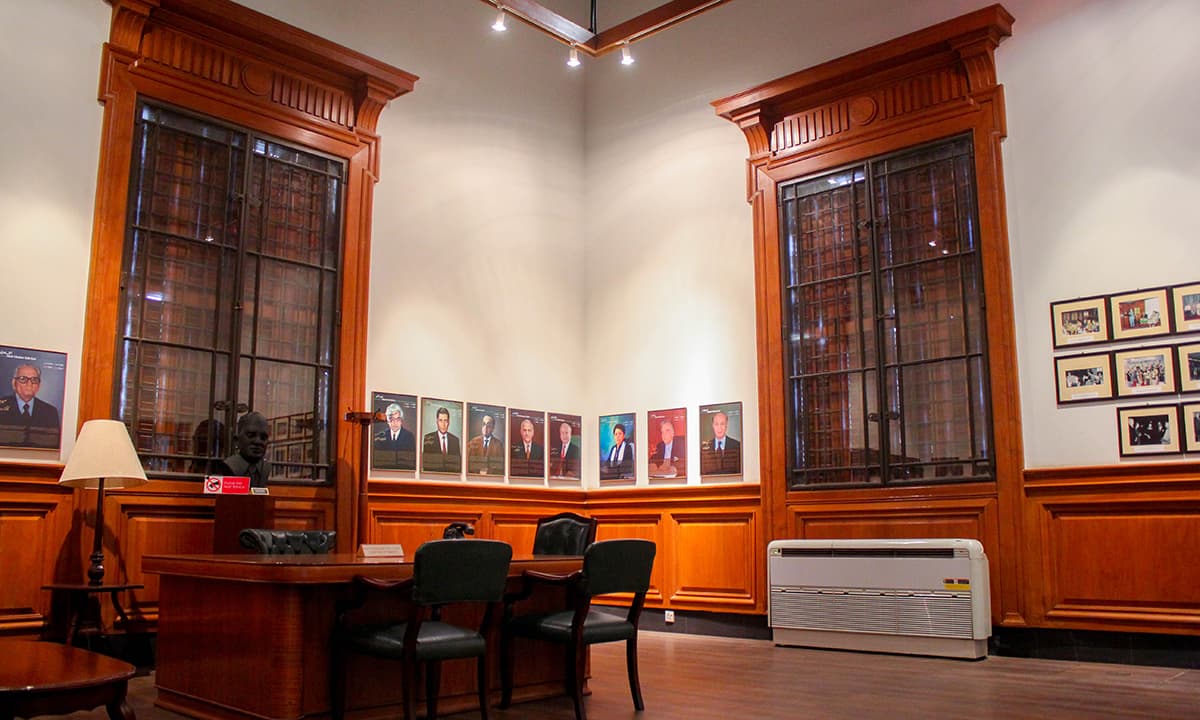By Yumna Rafi
 |
The State Bank Museum building which was previously the Imperial Bank of India.— Muhammad Umar |
The sprawling brown stone building of the State Bank Museum stands tall and lonely; one of many reminders of the British era that remain intact amidst the high rises on I.I Chundrigar road.
The museum that was once the Imperial Bank of India, now houses the archaeological treasures of the subcontinent. But the historical gems that the structure houses, remain unseen by many.
The building stands aloof, waiting to be admired by the outside bustle, which seems to be oblivious to the history inside.
Unveiling the gems
From the entrance to the mezzanine floor, this place offers a captivating journey through time; here you will find the earliest form of money used in the subcontinent, coins issued under Alexander the Great's rule, currency used during World War II and close to home, the largest collection of murals by Sadequain.
It took six years of research to compile the artifacts that are on display and with such wonders on offer, it comes as a surprise that the archaeological gems seem to attract very little visitors.
 |
The interior of the building. — Muhammad Umar |
 |
Japanese Invasion Money used during World War II.— Muhammad Umar |
 |
Stone used by the natives of Yap Island as money. — Muhammad Umar |
Coins of grandeur
 |
Inside the Governors’ Gallery where the furniture used by the first Governor of SBP, Zahid Hussain, is kept.— Muhammad Umar |
 |
Note printing machine. — Muhammad Umar |
 |
Photograph of Quaid-e-Azam Muhammad Ali Jinnah inaugurating the former State Bank building (now Supreme Court) and other rare photos.— Muhammad Umar |
The tour of antiquities begins with the splendid coin collection, which dates back to a time when uneven shapes of silver, weight about the same, were embossed with very simple but symbolic motifs ranging from animals to other elements of nature.
I was told that these were the first form of currency found in the subcontinent, dating back to 5th century BC
Fast forward to 300 BC and Alexander's incursion into the subcontinent, there's a marked difference in the look of the coins. Designs which conveyed stories about Greek gods and their prominence.
The coins depicted figures from Greek mythology, with the head of Herakles, also known as Hercules, on the front and of Zeus, 'the King of Gods', on the back, appearing on the majority of them.
Some historians have argued the image of Herakles was Alexander himself, there is no convincing evidence of this.
Apart from the regular currencies, the rare commemorative coin issued by Alexander after winning the 'Great War in Jhelum' against King Porus, is also secured in the museum as remnants of the King's biggest battle.
“A ruler was only considered powerful after he had issued a coin, it was a manifestation of a king’s prestige,” explained Tanvir Afzal, antiquity registrar at the museum.
The relics of the Greek civilization and the rulers that came in the subcontinent after Alexander, remain preserved in the State Bank museum in the form of coins.
It became apparent that these small pieces of metal not only had monetary value but also transferred the beliefs and cultures of that era. For centuries to come, the coins depicted warriors, kings on horseback, gods and deities.
 |
A collection of coins in the gallery. — Muhammad Umar |
 |
The coin galleries are divided between pre-Islamic and Islamic era. — Muhammad Umar |
With the coming of the Mughals, a paradigm shift occurred in civilisation; a Muslim era began and the change became evident in design and construction as well.
There were no more armours, nor any horses or king’s faces seen on the coins from this period. Instead, Persian calligraphy took over.
Among all the Mughal emperors, coins during Akbar’s era stood out in design.
They had decorative floral motifs, dotted borders and quatrefoil. Akbar’s coins were both round and square in shape typically with the kalma on the obverse (upper side) and “Jalaluddin Mohammad Abkar” engraved on the back.
“The coins during Akbar’s rule had variety and were also well refined. Upon introducing his religion Deen-i-ilahi, special coins were introduced,” says Afzal.
The Deen-i-Ilahi coins read “Allahu Akbar” which means God is great.
The lowest denomination coin was called “dam” and upon our curiosity, the museum registrar told us about its value. “From one single dam 20 kgs of raw materials could be bought at that time.”
As we ventured further, we were enlightened with more facts that we had previously not even wondered about.
The term “rupee” that is dominantly used in subcontinent to this day was derived from Sher Shah Suri’s ‘rupiya’, a Sanskrit term for silver coin
What was even more interesting was the coin that was issued in his era. It was a perfect round with an engraved Star of David on one side.
“Since Sher Shah Suri was a trader, this symbol may have been added to show solidarity with a country,” Afzal adds.
 |
Coins issued by Sher Shah Suri bearing the Star of David.— Muhammad Umar |
 |
A gold weighing machine used in the British era.— Muhammad Umar |
Another particular coin that stood out had Nur Jehan’s name, who became the only Mughal empress to have her name engraved in silver coins.
With the end of the Mughal era, once again the coinage of the subcontinent changed and was replaced with a broad variety: portraits of British rulers used by the East India Company, Sikh coins showing Guru Nanak, elephant engraves during Tipu Sultan’s rule.
Largest collection of Sadequain's murals
 |
Sadequain's ‘Industry and Agriculture'.— Muhammad Umar |
 |
Inside the Sadequain gallery.— Muhammad Umar |
 |
Sadequain's hand written notes.— Muhammad Umar |
The mezzanine floor of the museum houses four magnificent murals of Sadequain, making it the world’s largest collection of the artist’s work.
The columns are adorned by his collages, and a smaller room in the gallery resonates with glimpses of his life. A summary of all his works is displayed, as well as his own hand-written messages.
The mural ‘Treasures of time’, which is hard-to-miss, is displayed on a massive 60’ by 8’ canvas featuring 46 thinkers who had a lasting influence on the world for many years.
Interestingly, Sadequain included his own portrait amongst the mathematicians, scientists and philosophers. His murals ‘Industry and Agriculture I and II’ depicted the contrast yet harmony between a farmer and an industrial worker.
 |
A timeline of Sadequain's works.— Muhammad Umar |
 |
Painting "Freedom Fighters" by Zahoor-ul-Akhlaq in the Contemporary Art Gallery.— Muhammad Umar |
 |
Paintings in Contemporary Art Gallery.— Muhammad Umar |
Another room in the gallery is devoted to the young contemporary artists whose work is displayed without any cost.
“This gallery is solely for the artists who wish their work to be put up for public, anyone can approach us for it,” says Mohammad Zubair, paintings and gallery officer.
In the midst of deteriorating heritage in the country and ill-kept artefacts, this museum stands out with the efforts put in the preservation, a worthwhile visit for anyone looking for an insight into the treasures of the subcontinent.
 |
Collage by Sadequain.— Muhammad Umar |
 |
In the central hall is sculpture by Ismail Gulgee which is calligraphic piece with verses of the Quran.— Muhammad Umar |
 |
The souvenirs shop inside the museum.— Muhammad Umar |
So why doesn't anyone know of the marvels stored at the State Bank Museum?
One of the possible reasons for this neglect maybe the fact that since this is a government-run museum, many people wrongly view it as a drab that 'couldn't possibly have anything interesting in it.' That it is hardly promoted does not help its cause either but according to the Director of the State Bank Dr Asma Ibrahim, the problem may be as simple as a lack of parking space which repulses even the bank staffers let alone avid museum goers.
The other reason could be the fact that the museum is not open on Sunday.
“Though I tried my best, it is difficult to defend heritage anywhere in our country. Hopefully there will be better days for our country, I am optimistic about it," Dr Asma says.
There are always two sides to a coin and for those seeking to reinvent Karachi as a safe, diverse cultural landscape, the forgotten corridors may be the place to start. Besides, who would want to miss a chance to be in the presence of Sadequain?



